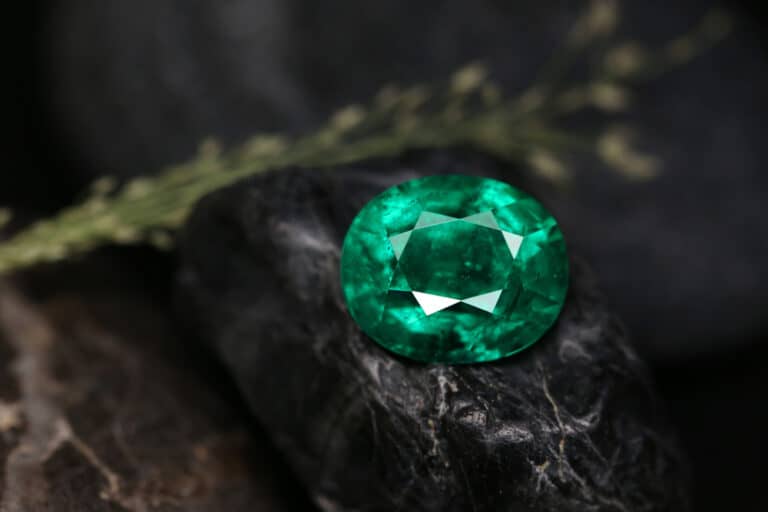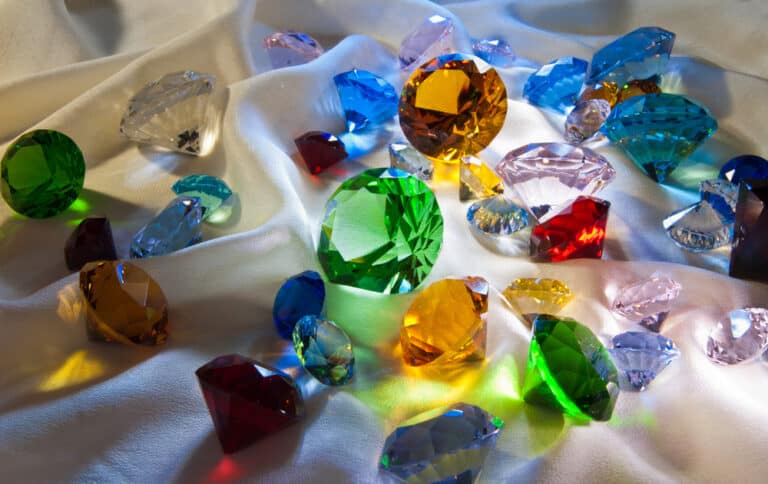Emeralds are one of the so-called Big Four gems, along with diamonds, sapphires, and rubies. Ancient tales tell of Cleopatra’s love of these green stones, while the Egyptians believed emeralds could grant everlasting youth. Why are emeralds still so prized and expensive today? Are emeralds rare?
Emeralds are rare, even more so than diamonds, because of their unique geological formation, limited geographical concentration, and the scarcity of high-quality mined and synthetic emeralds. They are in demand for their beauty, their rareness, and the prestige owning emerald jewelry bestows.
With their magnificent green hue, emeralds are beautiful members of the beryl family. The demand for jewelry made with these gorgeous stones is increasing as emeralds command ever-higher prices. Let’s examine why emeralds are in such demand and what makes them so special and rare.
Are Emeralds Rare?
Emeralds are some of the rarest and most expensive gemstones in the world.
These green beauties are 20 times rarer than diamonds, making them a high-end and discerning choice for engagement rings, neckpieces, and earrings.
Emeralds can command extraordinary prices. Colombian emeralds, the most desirable stones, can cost over $100,00 per carat, depending on size and color. (They are still not as expensive or popular as diamonds.)
As the desire for emeralds increases worldwide, the stones are becoming ever more scarce as supply cannot meet the demand.
A massive demand is only one reason why emeralds are rare. Explore more reasons for their rarity below.
What Makes Emeralds Rare?
Emeralds are rare because they are unique gemstones found in a limited geographical area.
Unique Geological Formation
So few emeralds exist because it takes a unique combination of geographical factors for them to form.
For an emerald to develop, three unusual elements must crystallize together: chromium, vanadium, and beryllium.
However, these three elements are seldom found together in natural geological formations, making their occurrence particularly special and almost miraculous. To put it in context, the chance of these three elements combining is as unlikely as someone winning the lottery three times in a row.
Each emerald is also unique, with its individual makeup of inclusions and imperfections that characterize these vibrant stones.
Limited Geographical Concentration
Emeralds were discovered by accident and occur on only a tiny part of the Earth’s crust, making them extremely rare.
More than 90% of the world’s emeralds come from South America. Columbia supplies the highest quality and highest number of emeralds in the world, while Brazil also supplies beautiful stones.
The African continent, with mines in Nigeria, Zambia, Madagascar, Tanzania, Zimbabwe, and Ethiopia, is second in world emerald production. Cleopatra’s ancient Egyptian emerald mines have long since run out.
A small number of emeralds also come from mines in China, Afghanistan, Cambodia, Australia, and the US.
New mines are seldom opened as no new emerald-rich areas have been discovered.
Scarcity Of High-Quality Stones
Because emeralds are found in so few places in the world, it makes sense that there aren’t many stones available, especially when compared to the other Big Four, including diamonds.
Not only are emeralds rare in general, but high-quality emeralds are particularly rare and, therefore, very expensive.
Only 10% of emeralds mined are suitable for making into jewelry. The best stones need to be the correct color and have the necessary clarity and saturation to be valuable. The most sought-after shade is medium to dark-toned green with vivid saturation and a slightly blue undertone.
It is extremely rare to find a flawless emerald. While emeralds are loved for their naturally occurring inclusions, inferior stones contain bubbles and imperfections rather than stem-like flaws. You shouldn’t be able to see the flaws with the naked eye.
It is also unusual to find large emeralds. Like any gemstone, the larger the emerald, the more expensive it is. One three-carat emerald is, therefore, worth more than three one-carat emeralds.
Emeralds are a wise purchase, nonetheless. Because emeralds are less dense than diamonds, an emerald will be larger than a diamond of equivalent carat weight.
Expensive To Produce Synthetics
A final reason emeralds are so scarce is that it is expensive and difficult to produce high-quality synthetic stones in a lab.
Lab-created emeralds exist but require expensive machinery, extended time, and intensive energy to produce.
Synthetic emeralds are, therefore, also scarce and expensive.

Why Are Emeralds In Demand?
There is a global demand for emeralds, particularly in the US and Japan, where over 75% of emeralds are bought. Columbian emeralds are the most desirable stones.
The demand for emeralds is not a new phenomenon. These stones have been mined for over 2000 years, with the earliest mines found in Egypt. Egyptians believed emeralds had magical powers and could confer eternal youth on the owner – they have been found in the burial goods in many tombs.
The Inca also regarded emeralds as having special powers and used emerald jewelry in religious rituals. The Romans associated emeralds with Venus, the goddess of love, which suggests they could make people fall in love. King Solomon, Rabbinic legend tells, was given an emerald as one of the four stones to rule over all creation.
While emeralds are no longer considered to have magical or ritualistic powers, they are considered precious. Today they are regarded as one of the Big Four, along with rubies, sapphires, and diamonds.
Emeralds are in demand for the following reasons:
- Emeralds are gorgeous, and each stone is entirely unique.
- These stones are still cheaper than diamonds and have a similar romantic and charming symbolism, so emeralds are becoming increasingly popular for engagement rings and birthstone jewelry. (May is the associated month.)
- A certain prestige is associated with owning expensive, precious stones and high-end emerald jewelry.
- They are a good investment, as supply remains limited.
Conclusion
Emeralds are some of the rarest gemstones worldwide, far rarer than diamonds. For emeralds to develop, they need unusual geological conditions found in only a few areas on Earth. High-quality emeralds are particularly scarce and desirable for jewelry. With synthetics not being a practical option, the demand for these fascinating stones remains high.
Resources
- https://www.angara.com/jil-magazine/are-emeralds-rare/
- https://www.diamonds.pro/education/emeralds/
- https://www.gemsociety.org/article/emerald-jewelry-and-gemstone-information/
- https://medium.com/@gemeraproject/why-the-demand-of-colombian-emeralds-is-growing-702989f39710
- https://www.mervisdiamond.com/blogs/blog/are-emeralds-rarer-than-diamonds
- https://www.quora.com/Why-are-emeralds-considered-rare-gemstones
- https://www.scmp.com/magazines/style/topics/jewellery/article/2043035/emeralds-are-miracles-nature-special






